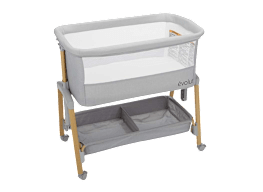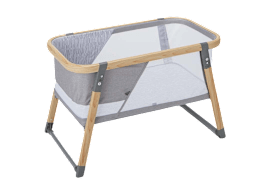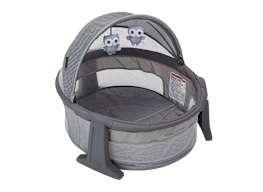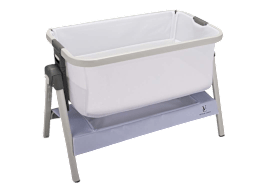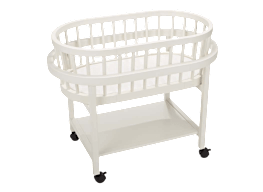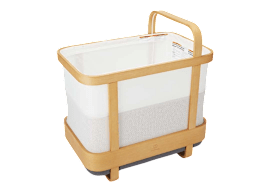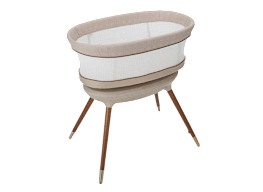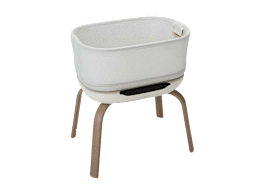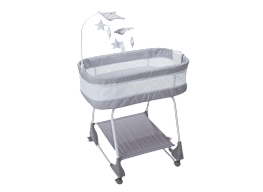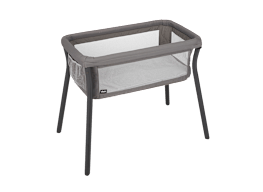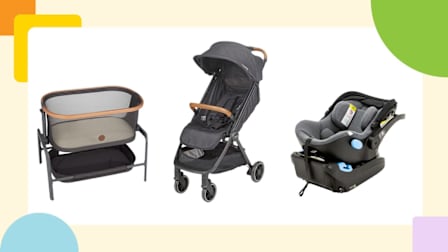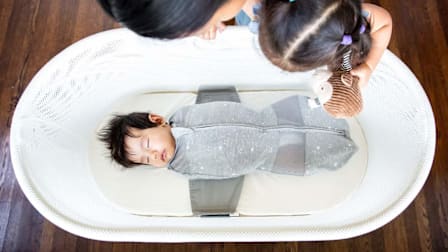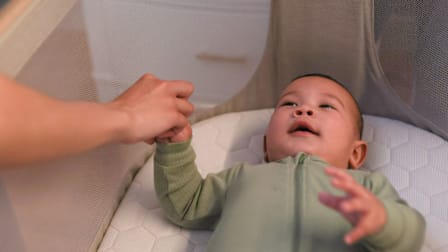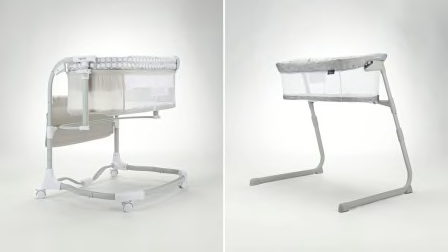Safe Bassinets Have These 6 Features, CR's Experts Say
Shopping for a bassinet for your baby? Here are the safety features to look for, plus the bassinets that impressed our testers.
When you shop through retailer links on our site, we may earn affiliate commissions. 100% of the fees we collect are used to support our nonprofit mission. Learn more.
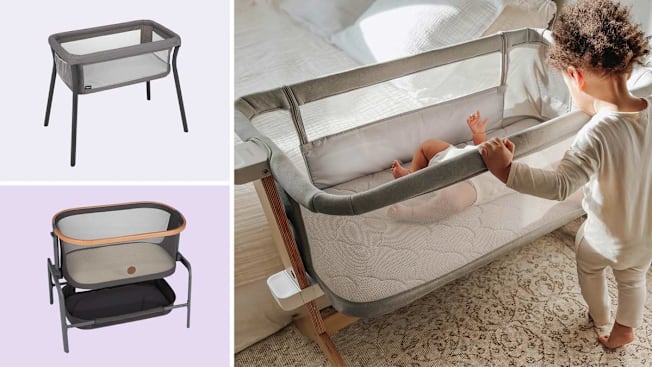
A bassinet can serve as a safe place to put your infant down to sleep, and its smaller footprint means you can often fit it next to your bedside or move it around your home more easily than a crib. Though a bassinet does have a relatively short period of use (you’ll need to transition to a crib once your little one starts to roll over or push up on their hands and knees, usually within the first 6 months), it’s still a convenient piece of baby gear to have on hand: Many families add a traditional bassinet, smart bassinet, or portable bassinet to their registry to help keep their baby close by and make room-sharing easier during the early months.
All bassinets sold in the U.S. are held to federally regulated standards for safety. Federal standards require that bassinets have a flat sleeping surface that doesn’t incline more than 10 degrees, and that they are built to support an infant’s weight and avoid tipping over (if a sibling pulls on the sidewalls, for example), among other factors. Bassinets and bassinet mattresses, just like cribs and crib mattresses, are also held to strict safety standards for toxic chemicals, like lead and phthalates.
How CR Tests Bassinets for Safety
When evaluating models for CR’s bassinet ratings, “we focus on safety first and foremost,” says Joan Muratore, the engineer who oversees CR’s bassinets and cribs testing. Muratore and her testing team evaluate a range of bassinets every year in the Consumer Reports test lab. Following the federal safety standard as a blueprint, they use a tool called an inclinometer to ensure that the sleeping surface never reaches an incline of 10 degrees or greater, which can be dangerous to a baby’s airflow.
Muratore says they also check the firmness of a bassinet’s sleeping surface and look for materials that promote airflow in the baby’s sleep environment, like mesh panels. And they assess real-world stability and tip-over risk by simultaneously applying vertical and horizontal forces that simulate the action a 2-year-old toddler would exert by pushing down on the edge of the bassinet while also pulling on it in an effort to see the baby.
Read our review of the best bassinets, which includes models from BabyBjörn, Chicco, Maxi Cosi, Snoo, and other brands.
6 Safety Features to Look For in a Bassinet
Making sure the bassinet you use has these features built in will help you and your baby rest soundly, which means a peaceful night for all.
1. A Sturdy, Flat Base
It’s important to consider the stability of your bassinet, given that it’s an elevated surface holding your baby. Muratore recommends testing out a few at a nearby store, if you’re able. There, you can push down on the sidewalls and nudge or shift the bassinet’s stand slightly to check how sturdy it feels. You may also want to avoid choosing a cantilevered bassinet that’s supported on only one side, given the risks our testers have seen with the Halo Bassinest Flex and the Ingenuity Dream & Go Bassinets, two cantilevered models. But don’t forget to inspect the bassinet’s footprint, too: Does it seem like the base could be a tripping hazard when you’re tiptoeing around it in the middle of the night? No twisted ankles, please.
2. A Tight-Fitting Mattress
Any bassinet that you buy should come with a snug-fitting mattress. When the mattress is centered in the bassinet, you should see no gaps between the edge of the mattress and the bassinet walls any larger than one-half inch, or about a finger-width. “A mattress that doesn’t fit tightly may shift around within the bassinet and bunch up or otherwise create a hazard where the baby’s face can be pressed into the mattress,” says Muratore.
When you put your baby down to sleep in the bassinet, remember that the bassinet mattress should be kept bare or covered only by a fitted sheet, with no blankets, bumpers, loungers, sleep positioners, nursing pillows, stuffed animals, or toys. The sleep surface should be relatively firm, too—enough so that it doesn’t compress underneath your baby’s weight. (A too-soft surface can create a suffocation risk for a young infant if they roll over.)
Muratore recommends looking for bassinets that come with at least one fitted sheet, rather than just a vinyl-covered pad. “The plastic pad may also encourage parents or other caregivers to put a loose blanket or cloth beneath the baby for their perceived comfort,” she says. That’s a big safety risk, according to Muratore, because any loose items create potential hazards for your baby.
3. Breathable Mesh Sidewalls
Your tiny gymnast may miraculously work themselves into a variety of strange positions during sleep, so you’ll want a bassinet with sidewalls that encourage airflow. Muratore suggests looking for walls made of mesh fabric. “All-mesh sidewalls are the best, but failing that, make sure that the portion of the sidewalls closest to where your baby’s face will be is made of mesh and not fabric,” Muratore says. “Avoid old-school bassinets with multiple layers of fabric.” Bassinets with solid sidewalls made of fabric or leather may look stylish but may also restrict airflow compared with those with mesh.
4. Locking Wheels
Some bassinets, especially those marketed as portable or for travel, may come with wheels to make them easier to move between rooms. This might be a helpful feature if you’re planning to move the bassinet to different parts of the house during the day for infant naps, and then into your bedroom overnight. Just make sure that those wheels also have a lockoff mechanism to keep them stationary so that a curious sibling or pet can’t give the bassinet an unwanted push.
Another safety note: Never put a baby in a portable bassinet on a raised or soft surface, like a countertop, couch, or bed. “Not only have babies been injured in falls from these raised surfaces, but the soft surface may allow the bassinet to tip, putting the baby in an unsafe position or suffocation on the surface of the bed or couch,” says Nancy Cowles, child product safety expert and former executive director of the child product safety nonprofit Kids In Danger.
5. Sound Settings With Volume Control
Smart bassinets can detect a baby’s cries or discomfort and automatically respond with soothing motions and sounds—or alert a caregiver to turn on these features to help keep a baby calm. But guidelines from the American Academy of Pediatrics (AAP) recommend ensuring that any white noise or similar environmental sounds are kept below 50 decibels to protect a baby’s hearing. In CR’s smart bassinet testing, we found that several smart bassinets’ sound and music options, when played at max volume, were well over the 50 dB mark (you can see the decibel ratings on each of our smart bassinet ratings pages). Check to see whether the bassinet you’re considering offers volume adjustment so that you can stay under that sound threshold.
6. Mobiles or Canopies That Are Well Out of Reach
Any mobile that comes with your bassinet should be far enough away from reaching hands that it doesn’t pose a risk to your infant. It should also be securely installed so that it won’t accidentally fall inside the bassinet (if you’re worried about it, just remove it entirely). “Look for bassinets that, like cribs, are simple structures without attachments that can become a hazard,” says Cowles. “Older siblings or even caregivers might not understand the risk a low-hanging mobile or other items can pose.” Canopies that block light and drape over a bassinet’s opening can be beautiful but may also pose a safety risk. Better to just use a blackout window shade or double-lined curtains on the windows if you’re aiming for a darker sleeping environment.
Safest Bassinets From CR's Tests
Bassinet Safety Guidelines
The AAP recommends using a bassinet, crib, or portable play yard as a safe sleeping environment for your baby. Follow these safe sleep guidelines when using a bassinet for every nap and nighttime sleep.
- Always place your baby down on their back in their own sleeping space, with no other people or pets.
- Babies should sleep on a firm, flat—not inclined—surface. Inclines of 10 degrees or greater can restrict your baby’s airflow.
- Use only a fitted sheet in your baby’s sleeping space.
- Keep toys, blankets, bumpers, pillows or nursing pillows, baby loungers, sleep positioners, and other items out of the bassinet. These items can potentially suffocate your baby. (Bumpers, in fact, are banned under the Safe Sleep for Babies Act.)
- Do not use weighted sleep sacks.
- If your baby falls asleep in a car seat, stroller, swing, or infant carrier, move them to a firm sleep surface on their back as soon as possible.
- If you decide to use the white noise or sound features available on some of the bassinets we reviewed, use the lowest possible setting for a brief time, and if possible, position your baby’s head on the opposite side of the bassinet from where the speaker is placed.
Talk to your pediatrician for more safe sleep recommendations and guidance for your family.

















